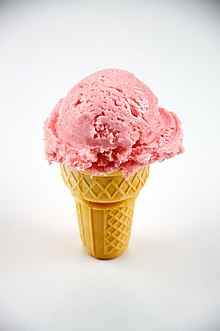Ice Cream Cone

A wafer style ice cream cone with strawberry ice cream.
|
|
| Type | Pastry |
|---|---|
| Serving temperature | Dry and cold |
| Main ingredients | Flour, sugar |
| Variations | waffle cone, cake or wafer cone, pretzel cone, sugar cone, chocolate-coated cone, double cone, vanilla cone |
| 23 kcal (96 kJ) | |
| |
|
An ice cream cone, poke (Northern Ireland and Scotland) or cornet is a dry, cone-shaped pastry, usually made of a wafer similar in texture to a waffle, which enables ice cream to be held in the hand and eaten without a bowl or spoon. Various types of ice cream cones include wafer (or cake) cones, waffle cones, and sugar cones.
Many styles of cones are made, including pretzel cones and chocolate-coated cones. A variety of double wafer cone exists that allows two scoops of ice cream to be served side by side. Wafer cones are often made with a flat bottom instead of a pointed, conical shape, enabling the ice cream and "cone" to stand upright on a surface without support. These types of wafer cones are often branded as "cups".
Edible cones were mentioned in French cooking books as early as 1825, when Julien Archambault described how one could roll a cone from "little waffles". Another printed reference to an edible cone is in Mrs A. B. Marshall's Cookery Book, written in 1888 by Agnes B. Marshall (1855–1905) of England. Her recipe for "Cornet with Cream" said that "the cornets were made with almonds and baked in the oven, not pressed between irons".
Edible cones were patented by two entrepreneurs separately in the years 1902 and 1903. Antonio Valvona, an ice cream merchant from Manchester, UK, patented a biscuit cup producing machine in 1902, and in 1903, Italo Marchiony, an ice cream salesman from New York filed for the patent of a machine which made ice cream containers. Abe Doumar and the Doumar family can also claim credit for the ice cream cone.
At the age of 16 Doumar began to sell paperweights and other items. One night, he bought a waffle from another vendor transplanted to Norfolk, Virginia from Ghent in Belgium, Leonidas Kestekidès. Doumar proceeded to roll up the waffle and place a scoop of ice cream on top. He then began selling the cones at the St. Louis Exposition. His "cones" were such a success that he designed a four-iron baking machine and had a foundry make it for him. At the Jamestown Exposition in 1907, he and his brothers sold nearly twenty-three thousand cones. After that, Abe bought a semiautomatic 36-iron machine, which produced 20 cones per minute and opened Doumar's Drive In in Norfolk, Virginia, which still operates at the same location over 100 years later.
...
Wikipedia
